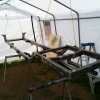After some research I ordered a distributor and coil for an 83 Mustang, it installed perfectly and looked like it was going to work ok. This is an electronic distributor so it will fire an electronic ignition module. Some more research determined that the GM HEI module word work with it as others have used it in similar installations. Some people have said that the HEI module is prone to failure from overheating because it is located inside the GM distributor but with it now being located outside in the breeze it should be more than reliable enough.
All this brought out another more serious problem, the top of the distributor cap hits the FI manifold, and by a lot. I thought I might be able to grind some aluminum off the manifold and get enough room but that was not going to work. I do not know why Ford made the distributor cap so high, I have not been able to locate a lower one so we are just going to have to live with it.
I have been conferring with the folks at TheRangerStation web site, they have a lot of accumulated knowledge on the Ranger pickups and the 2.3L engine. According to the members there nobody has succeeded in converting the newer 2.3L engine back to carbs and a distributor ignition, or at least no one has done it and said how it was done. One of the suggestions made was to use the cylinder head and intake manifold from an older model engine with a distributor. I do not want to do that, discarding a perfectly good cylinder head did not make any sense to me plus all the trouble and expense to find the needed parts, install them and then who knows what other problems would show up.
After a lot of thought and deliberation I decided I was going to have to fab up my own intake manifold.
 Can be sanded , shaped & painted. This piece shown in my photo is half round , it's a half inch tall & a inch wide. It can also be purchased in a quarter round size which is three quarter of an inch tall by three quarters of an inch wide. Put them together & you have a half round moulding that is three quarters of an inch tall by one & a half inches wide. It requires urethane glue for adhesion. This will provide a form for the reveal. Once again , it's your choice. Your project looks great.
Can be sanded , shaped & painted. This piece shown in my photo is half round , it's a half inch tall & a inch wide. It can also be purchased in a quarter round size which is three quarter of an inch tall by three quarters of an inch wide. Put them together & you have a half round moulding that is three quarters of an inch tall by one & a half inches wide. It requires urethane glue for adhesion. This will provide a form for the reveal. Once again , it's your choice. Your project looks great.





